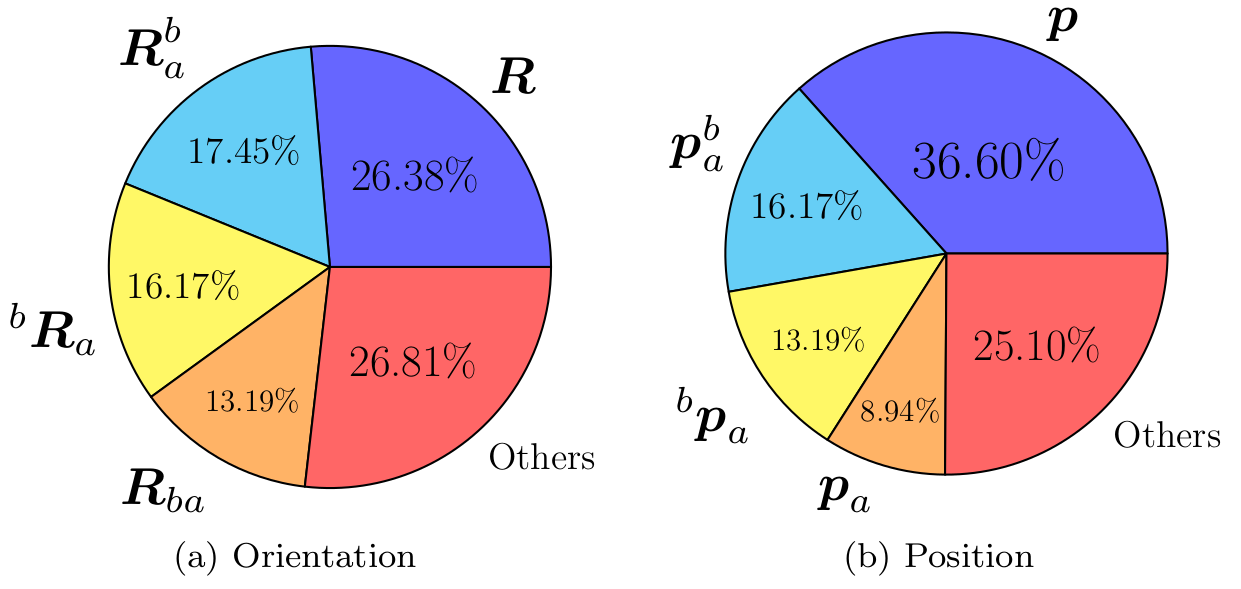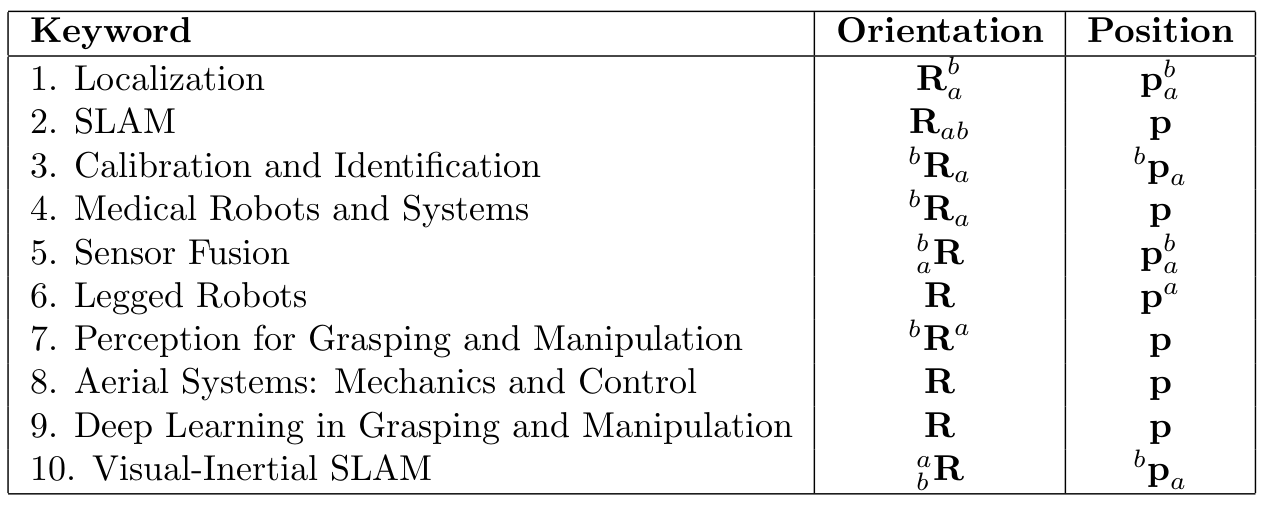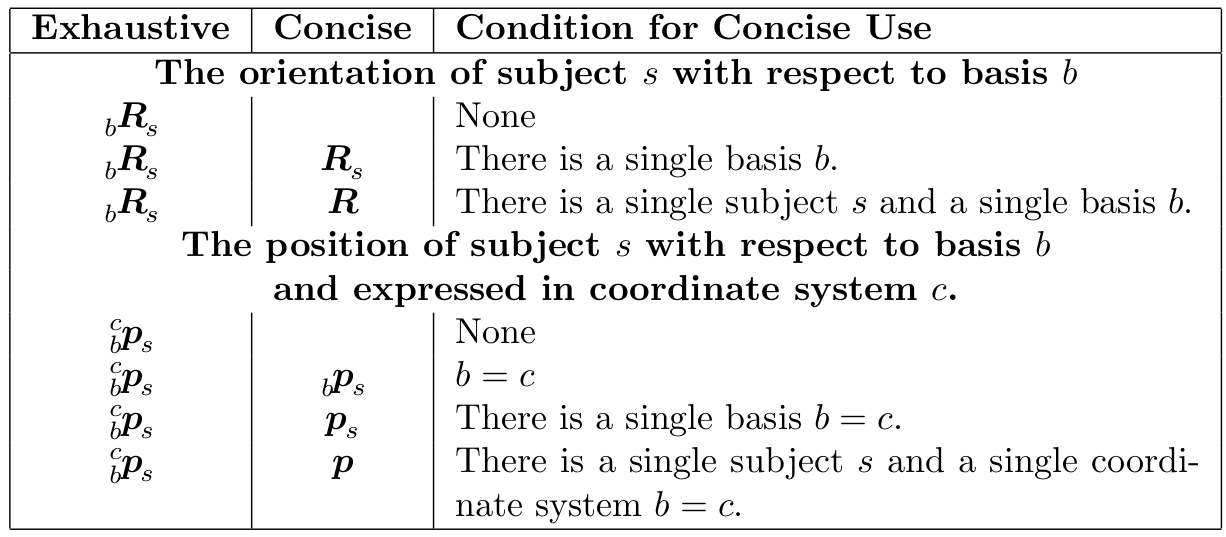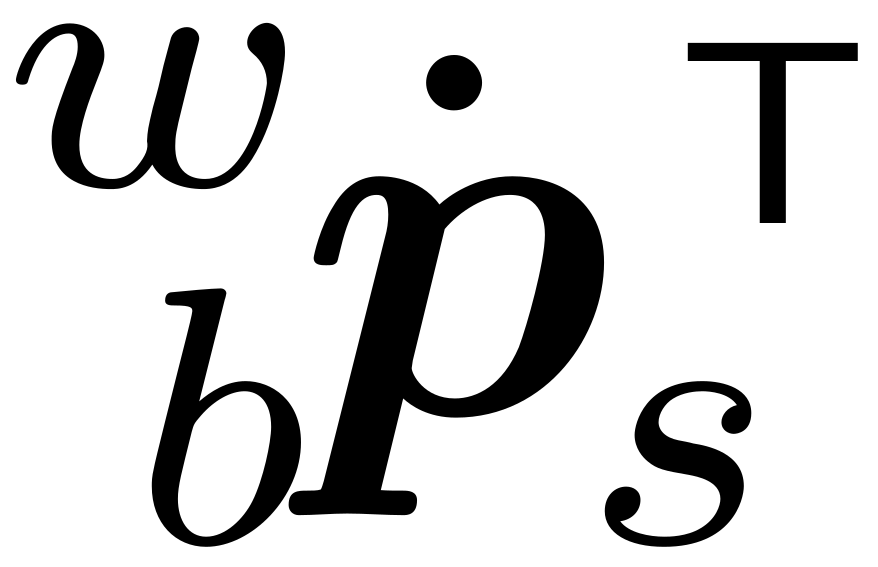A Standard Notation for Robotics
RIGID – A concise yet unambiguous rigid transformation notation convention
From my report:
A Standard Rigid Transformation Notation Convention for Robotics Research
By Philippe Nadeau
🔗 Report 🔗 LaTeX Package
Ever wondered how rigid transformation notations are used in robotics?
Rigid transformations are fundamental to robotics, yet there is no widely accepted standard for their notation. How do researchers define them? When should we allow notation simplifications? How can we ensure clarity while remaining concise? These questions drove a large-scale analysis of the ICRA 2023 proceedings and the development of a new notation convention: RIGID.
Analyzing ICRA 2023 Papers
As a side project, I conducted a detailed study of all 1655 papers presented at ICRA 2023. Every paper was inspected to identify whether it used rigid transformations and, if so, which notation convention was adopted. In total, 242 papers (about 15%) included rigid transformations, providing a dataset for analyzing how notation conventions are used across robotics subfields.

 On the left, the usage statistics of different notation conventions in the ICRA 2023 papers. On the right, the dominant notation conventions in various robotics subfields. Note that, within each subfield, variations in notation is prevalent but only the most common conventions are shown.
On the left, the usage statistics of different notation conventions in the ICRA 2023 papers. On the right, the dominant notation conventions in various robotics subfields. Note that, within each subfield, variations in notation is prevalent but only the most common conventions are shown.
Key Insights
- Notation inconsistency: There is no single dominant notation in robotics. The most commonly used conventions split almost evenly across different styles.
- Conciseness over exhaustiveness: While exhaustive notations are theoretically preferable for clarity, most researchers favor compact forms.
- Field-dependent preferences: Certain notations are more common in specific subfields, but even within those, variations exist.
Introducing the RIGID Notation
To address these inconsistencies, I defined RIGID, a new notation convention designed to be:
- Unambiguous – There cannot be any confusion about the meaning of the notation if the rules of RIGID are followed.
- Well-defined – Specific conditions determine when (and how) a concise form of the notation can be used.
- Concise – Only the necessary information is included in the notation.
- Compliant – Compliant with the ISO 80000 standard on Quantities and Units.
- Easy to adopt – A LaTeX package is available to facilitate its use in research papers and technical reports.
In robotics, it is convenient to associate reference frames with rigid bodies to concisely describe their position and orientation, for example. Defining a position vector requires, at the very least, specifying two elements: a subject and a basis. The position vector describes the position of the subject with respect to the basis. Additionally, specifying a coordinate system for a vector enables expressing it in terms of its coordinates, which is usually desired in robotics to facilitate computation. Hence, an exhaustive notation for a position vector should include the subject, the basis, and the coordinate system. Defining an orientation requires specifying two reference frames, which will be referred to as the subject and the basis. With the subject reference frame fixed to a rigid body, the orientation can be described by expressing the axes of the subject with respect to those of the basis.
Hence, an exhaustive notation should include:
- Quantity: The type of quantity being described (e.g., position, orientation, velocity, acceleration).
- Subject: The reference frame fixed to the rigid body.
- Basis: The reference frame to which the subject is related.
- Coordinate System: The coordinate system in which the quantity is expressed.

Definition of the RIGID notation convention for vectors and orientation with subject s, basis b, and coordinate system c. Following ISO 80000, when boldface is not available, an arrow can be drawn under the quantity symbol.
The role of a notation convention is to encode semantics into symbols, providing meaning to a mathematical expression. A functional convention should allow mapping back from symbols to semantics; the encoding should be reversible. Unfortunately, many people do not follow a convention that allows this reverse mapping, leading to confusion and misinterpretation in the mathematical expressions. The RIGID notation convention aims to address this issue by providing a structured and concise way to represent rigid transformations in robotics.

Rules for using a concise notation when referring to the orientation and position of a reference frame.
The RIGID Notation LaTeX Package
To facilitate the adoption of the RIGID notation convention, I created a LaTeX package that simplifies the formatting of vectors and matrices in a structured and consistent way. The package allows users to define custom commands for common mathematical quantities, making it easier to write and read equations in robotics research.
Installation
The package can be easily installed by following the instructions in the respository’s README.md. Once installed, it can be included in LaTeX documents using:
\usepackage{rigidnotation}
Defining Notation Commands
Before using the package, users can define their own notation commands in the preamble. For example, to define velocity and acceleration vectors:
\NewRigidNotation{Vel}{v} % Velocity
\NewRigidNotation{Acc}{a} % Acceleration
The first argument (Vel, Acc) is the command name, while the second (v, a) is the symbol used in equations.
Using Notation in Equations
Once defined, these commands can be used in math mode with various arguments to typeset a concise representation of the quantity. For instance,
\begin{equation}
\Pos[\dot]{s}{b}{w}\Tran
\end{equation}
produces

which very concisely represents the time-derivative of the position vector of subject s with respect to basis b when expressed in coordinate system w. When typing the keystrokes, you can think: position of s with respect to b expressed in w, transposed. The order in which the elements are typed respects the order in which they can be spoken, making it easier to remember the order of the arguments.
This produces a clear and structured representation of the velocity and acceleration of a subject s with respect to a basis b, expressed in coordinate frame w.
Concise Notation for Readability
By default, the package includes an option for concise notation, which omits the coordinate system when it matches the basis:
\SetConciseNotation{\BooleanTrue}
This ensures that expressions remain compact and readable while still being unambiguous.
This package provides a powerful yet simple way to maintain notation consistency in robotics research papers. The full documentation, including additional options for transposes, inverses, and Hermitian operations, is available with the package.
For more details, check out the full CTAN package at https://ctan.org/pkg/rigidnotation.
